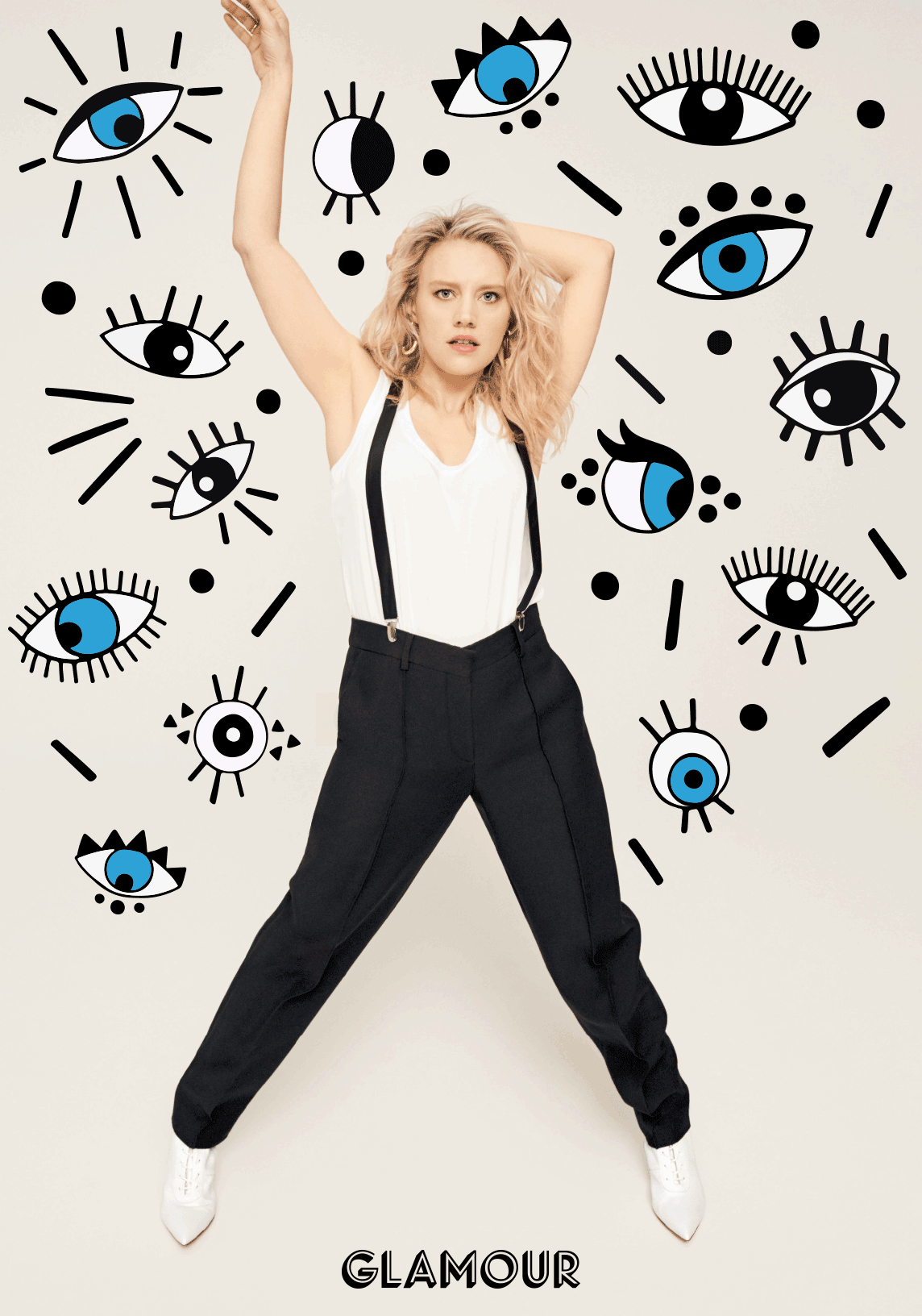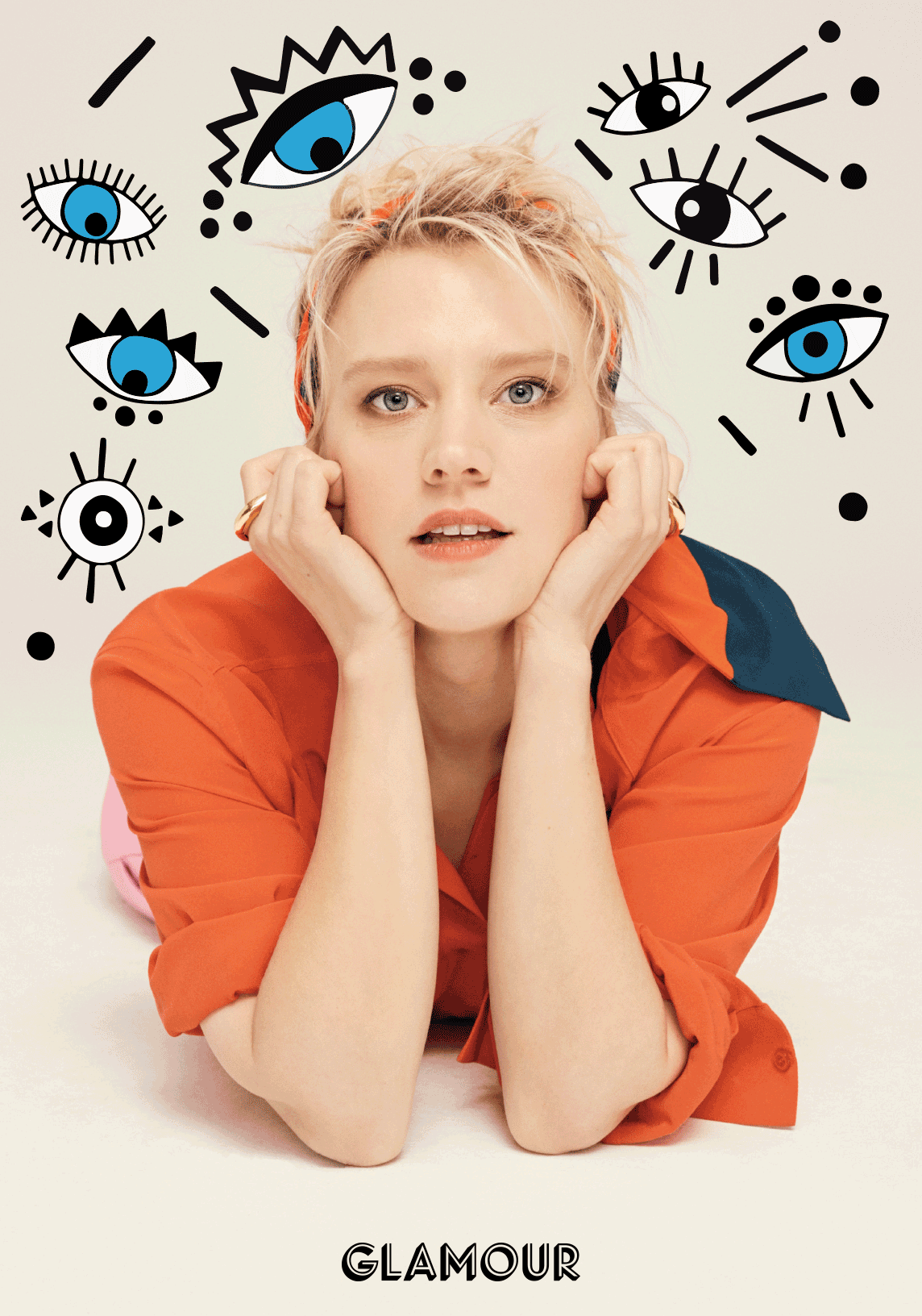Introducing Kate McKinnon, Movie Star
.gif)
Kate McKinnon is unpacking her lunch onto the New York City sidewalk. “If I could talk to everyone on this street, I would,” she says. “I’m always on the hunt for people—something I like about them or something that hooks me about them.” It’s the one o’clock lunch rush on a Thursday, and we are squatting on a six-inch ledge that separates a row of hedges in Rockefeller Center from 49th Street, balancing takeout containers on our knees. Tourists step around us on their way to 30 Rock without recognizing the Saturday Night Live standout in their midst. “I swear I’m not doing this so you have something interesting to write in your piece,” she says. “It’s just—where else is there to sit?”
McKinnon joined SNL in 2012 and now, at 34, is its longest-serving female cast member. She has built a career on the sweet eccentricity of her characters: Hillary Clinton unable to mask her longing for validation; Justin Bieber playing at a sexual persona he hasn’t yet grown into; Ruth Bader Ginsberg high on her own badassery. These renditions—precise, uproarious, tender—have earned her two Emmys, an army of devotees, and a rising career in film. Despite the quantity of material she produces each week for SNL, she never falls flat. It doesn’t matter who she’s playing or how deep in her archive you go, she’s like the hot sauce of TV: Put her in anything, and it gets better. I wanted to know how she manages that level of consistency. Does she have some kind of system?
“So many YouTube videos,” McKinnon says. “Me, alone in my office, talking back to YouTube videos.” She mulls the question, breaking down the order of operations in her mind: “I like to devise axioms and notice patterns of what works and what doesn’t so I can codify those into little rules I can use. If someone has a vocal tic or an accent, it’s so much easier to hook into something. It always starts with the way they talk, and then you add the layer of their energy.” A basic resemblance is usually necessary, though she’s been known to stretch that guideline (see: her leering Rudy Giuliani). “Then it all depends on what they’ve done that week,” she says. “They can’t just be someone who did something five months ago. It’s got to be à la minute.”
At the core of any impression is what sketch comedians call “the game.” The game is the unexpected conflict buried at the center of a person. “With Jeff Sessions it’s his joy and impishness versus his being a political figure with a very important job,” McKinnon says, suppressing a smile. “That’s the genesis of a game, which you can then heighten: the juxtaposition between someone who is buttoned up and someone who is emotional.”
I ask whether you can win the game. Can you push the juxtaposition so far or heighten the inherent conflict so deftly that there’s nothing left to do? “No! That’s the beauty of sketch comedy; the game never ends,” she says. “No one ever really changes. In sketch, the person’s doomed to keep repeating their own foibles. They can’t get better.”

Kate McKinnon grew up in a small town on Long Island, the daughter of parents who loved Mel Brooks and Christopher Guest movies. Her father, the late architect Michael Berthold, introduced her to Saturday Night Live when she was 12, and being on the show became, she says, “my only dream.” After studying theater at Columbia University, she joined the cast of The Big Gay Sketch Show, a vaudevillian comedy series created by Rosie O’Donnell, and performed for six years at the Upright Citizens Brigade. When she was 28, her only dream came true.
If there’s a “game” about McKinnon, it’s the contrast between the fearless abandon of her performances and her reserved offscreen persona. It’s easy to assume that someone who holds nothing back while entertaining—just watch her lick Lady Speed Stick off Charles Barkley’s face—holds nothing back in real life. But she’s retiring in person, with a low voice and a shrugging discomfort with talking about herself. It is rumored that she doesn’t like being photographed unless in character (though she obliged Glamour for this shoot), and in interviews she seems to mentally test each sentence before saying one aloud. “She is very, very, very, very shy,” says Mila Kunis. “One of the most shy people you’ll ever meet. Just very quiet.”

Just Warming Up “It always starts with the way they talk,” McKinnon says of creating her famous impressions. “And then you add the layer of their energy.”
Michael Stars tank, $98. Valentino pants. Wolf Circus Jewelry ring, $160. Lady Grey earrings, $180. The Tie Bar suspenders, $25. Gianvito Rossi boots.

Givenchy shirt, scarf worn as headband. Banana Republic pants, $98. Kenneth Jay Lane hoops, $75. The Tie Bar suspenders, $25.
McKinnon is the first out lesbian on SNL and one of the most famous gay women in America. Because of these facts, she is frequently asked about her sexuality, though she consistently declines to discuss her personal life. She seems to prefer to put pieces of herself—and her queerness—into her characters: the perfect drag of her Bieber bit, the unabashed flirtiness of Holtzmann in Ghostbusters, the hints of high camp when she plays ultrafeminine women.
This month marks the release of The Spy Who Dumped Me, which stars Kunis and McKinnon as Audrey and Morgan, best friends who get embroiled in a little international espionage. Morgan, an actress with a penchant for splashy displays and a ferocious love for Audrey, is the largest film role McKinnon has ever played—she isn’t just the comic relief. Morgan’s “performative oddball” qualities come packaged with what the film’s cowriter and director, Susanna Fogel, calls “the insecurity people have when they feel like they’re only lovable when they’re ‘on.’”
That hooked McKinnon. “I connected to this character on a level I didn’t expect,” she says. “The character is an actrice who is very performative. And I am that way as well. Sometimes I feel like that makes me unique and wonderful, and sometimes I feel like that makes me someone that people would rather have leave the room.” Preparing for this film, she worried about whether she might be off-putting in large doses. “I didn’t know what it would be like for me—being me—to be onscreen that much. Would people be able to tolerate it?” she says. “In all of the roles I had done prior, I was more of a side dish, a wonderful creamed spinach. And the creamed spinach can afford to be as odd as the creamed spinach wants.”
The main dish, however, has to be more complex. A main dish has to have an arc and grow, which permits an actor fewer disguises. “I spend so much time in wigs and doing these voices that having to use my own voice made me feel quite naked,” she says. She recalls begging Paul Feig, who directed Ghostbusters, to let her use a Russian accent for the entire movie. While shooting The Spy Who Dumped Me, Fogel says, she often encouraged McKinnon to “play it real, take it down.” (Once, in a moment of playful panic, McKinnon teased, “Don’t make me act, you hateful witch!”)
“I didn’t know what it would be like for me—being me—to be onscreen that much. Would people be able to tolerate it?”
Fogel saw McKinnon change on set: “By the end she learned to trust that she’s an actress as well as a comedian, and that she is actually worthy of that level of depth and introspection in the character.” The experience also expanded her sense of what kind of film career she might want. Her models are Gene Wilder for career arc and, for pure ability, “what other answer is there besides Streep? It’s all Streep,” she says. Does she have Streepian aspirations? “We’ll see how it goes,” she says. The Spy Who Dumped Me may not be Sophie’s Choice, but it gives a sense of what McKinnon might do once she branches out from sketch comedy more permanently. She flourishes in Spy, where she’s given space to show a greater depth and nuance of emotion, to holler one-liners in a car chase and then, in the next scene, be sincere or quiet. In the movie’s most genuine moment of pathos, she cries.
“An audience will follow her anywhere,” says Feig. Someone becomes a star, he says, because “the audience sees themselves in you. And you normally don’t get that with somebody who plays crazier characters.” But McKinnon is an exception. “She truly loves people, and I think that comes across on the screen,” he says. “That’s an unpredictable quality, like charisma. You can’t train that into somebody.” Feig is hinting at something that I heard in my conversation with Fogel: Kate McKinnon isn’t just a comic genius; she’s a nascent movie star. We’ve all just been laughing too hard to notice.

The Payoff “If you convey something true and other people also find it true, you feel a sense of gratification unlike anything else.”
Frame blazer, $550, pants, $295. Ben-Amun by Isaac Manevitz earrings, $145. Calvin Klein Jeans boots, $249.
A few days before Mother’s Day, SNL’s guest star Amy Schumer, McKinnon, and a group of cast members are rehearsing a game show parody called “Mother Knows Best!” Schumer plays the host, quizzing mother-child duos. McKinnon is “Ebisaleth,” a mother from “Fortress of the Lamb, Pennsylvania,” whose relationship with her son, played by Mikey Day, gets more inappropriately intimate by the moment.
McKinnon is workmanlike and focused, dressed in black jeans and a pair of slippers. She’s physically affectionate and has a generous laugh—quick to find her scene partner funny, quick to snap back to attention. The technical challenge of this rehearsal is a piece of blocking: Schumer’s character asks all the mothers to leave, but Ebisaleth refuses to part with her son. McKinnon is also supposed to arrive center stage for a separation-anxiety meltdown.
What happens next is a master class in incremental improvement. With each run-through, McKinnon makes a small change: She doesn’t just walk away; she clutches Day and begins to weep. She doesn’t just weep; she sobs. She doesn’t just sob; she collapses to the floor with a protean howl. Every take she finds a new detail to add, a funnier way to hold her hands, a funnier way to breathe, something to push the stakes higher. “Comedy is a compulsion,” she later tells me. “I have to be writing something or playing the piano or doing something. It’s a compulsion.”
According to her coworkers, that compulsion presents itself in obsessive preparation. “It doesn’t matter how late the pretape or how early the call time, if you’re passionate about it, she wants to give it her all,” says Sudi Green, who writes with McKinnon on SNL. Kunis saw this during filming too: “Kate sits down in the morning and writes out a thousand versions of the joke. You look at her and go, ‘Oh my God.’ She’ll spend hours doing it.” When I ask Colin Jost, with whom McKinnon often writes, to characterize her talent, he nods to “the gap between how meticulous she is as a writer and how loose and free she is as a performer. She can be very cerebral when she’s writing,” he says, “but when you see her on camera, she is able to completely let go.”
When I finally see her perform live at SNL, the moments I am most struck by are not her time on camera but the way she waits in the wings. She is grave and still, standing in the dark with her eyes on the monitors, watching the camera angles. She doesn’t talk to anyone or seem to hear the audience laughing. She looks like a slingshot stretched tight, ready to release.

Funny That Way “Comedy is a compulsion. I have to be writing or playing the piano or doing something.”
Theory blazer, $595, pants, $325. Alternative Apparel T-shirt, $42. Kenneth Jay Lane earrings, $90. Joanna Laura Constantine ring, $190. Tibi boots, $695.
Eventually a cop tells us to get out of the bushes in Rockefeller Center. We drift around for a few blocks, settling on the steps of St. Patrick’s Cathedral. I ask her when she knows she “has” a character and the work is ready. She looks at the sky. “When you have it, it feels easy, fun, joyful, and it feels true,” she says. “Like you’ve distilled the essence of somebody.”
The question of truth—locating it, capturing it, and sharing it—comes up several times. When I suggest that maybe she’s a perfectionist, she thinks for a while. “It’s not really perfection that is the goal for me; it’s more the pursuit of truth,” she says. “If you convey something you find true and other people also find it true, you feel a sense of gratification unlike anything else. So I suppose I am relentless in my pursuit of that.”
“And when you don’t get there?”
She begins to demonstrate physical panic, the way anxiety rises up into the throat. “If you can’t figure it out in time,” she says, “you feel like you’re squandering something precious, which is the chance to communicate and connect. And I hate that!” She laughs and then repeats herself more quietly, “I really hate that.”
“It’s not really perfection that is the goal for me; it’s more the pursuit of truth.”
Tired of talking about herself, she tries to turn the interview around. “What is your dream?” she wants to know. “Like, what is your greatest dream?” I promise to answer if she does. “I continue to be gobsmacked anytime I get an opportunity to work. And I don’t see that going away,” she finally says. “I wouldn’t ever want to stop looking around a set and going, ‘Holy shit. How do I keep this going? How do I do this again? I have to do this again.’”
“Compulsion,” I suggest.
This tickles her. “Yes! I wonder if it ever goes away for anyone? I haven’t asked.” Her voice tenses slightly, indicating a laugh is on its way. “I wonder how Streep feels. Streep’s gotta know.”

